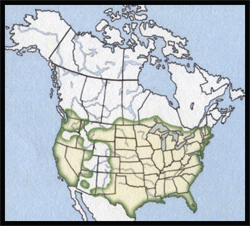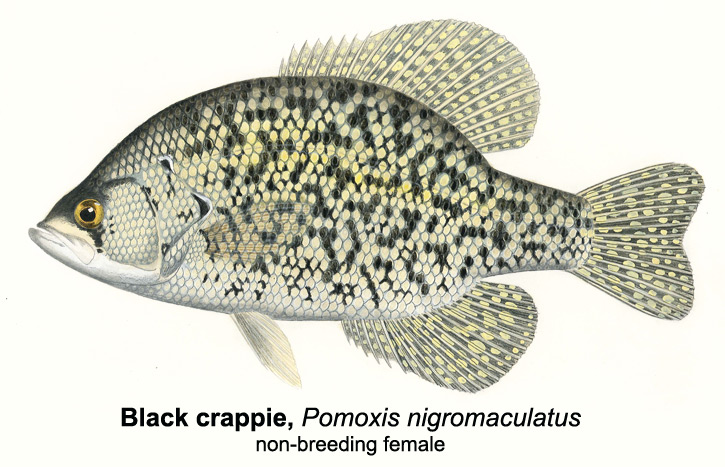Black Crappie, August 2015, Fish of the Month!
Black crappie
Pomoxis nigromaculatus
Local Names:
Calico bass, Straw bass, Grass bass, Strawberry bass, Mason perch, Sac-a-lait, Lamplighter
Average Size:
8 to 12 inches
½ to 1 pound
Distinguishing Field Marks:
(See the illustration.)
-
The body is more strongly laterally compressed, considerably deeper from top to bottom, and not as elongated as that of the White crappie.
-
In non-spawning adults the patterns of markings on the body and fins are much darker and more distinct than those of the White crappie.
-
Unlike the White crappie, the Black crappie has a dark triangular patch extending downward from the lower edge of the eye.
The first dorsal fin has 7 or 8 spines and originates much further forward on the body than that of the White crappie.
North American Range:
Map to the right shows approximate range in North America.
Diet:
Beginning with tiny aquatic invertebrates, especially small insects, which continues through early adulthood, and later increasing in adults, to also include a significant percentage of small fishes.
Biology:
The Black crappie spawns from late winter into early summer, depending on location,. As in all the sunfishes, the males select the gravel or mud bottomed nest sites in 3 to 8 feet of water close to vegetation and fan debris from them with their fins. Black crappies nest in dense colonies where the males spend much energy on protecting their territories. When females arrive, they are courted by individual males and the spawning act begins. The pairs swim about the nest and release small amounts of eggs and sperm, until the female moves off to mate with another male or until she has released as many as 10,000 to 180,000 eggs. The fertilized eggs are adhesive and attach themselves to the bottom of the nest where they incubate for 3 to 5 days, all the while being aerated by their male parent who also protects them for a short period after they have hatched and begin to leave the nest. The young grow rapidly and usually attain a length of 1 to 3 inches by the fall of their first year.
Fly Fishing for Black crappie:
Black crappie are most abundant in ponds, small lakes, the shallower areas of larger lakes, and the slower portions of rivers. They seek warm water and are typically found near the cover of aquatic vegetation, submerged brush piles or other structure. They may also sometimes feed actively in schools in open water and for this reason can provide an angler with plenty of activity over a relatively short period of time. Black crappies will occasionally be seen feeding at the water's surface, but are much more reliably found suspended at mid-water depths. They typically feed most freely from late afternoon into early evening and then again, under the cover of darkness, in the very early morning hours.
Because they are sight feeders, Black crappie will take whatever flies you get close to them that meet or exceed their dietary preferences. They can be caught on dry flies, wet flies, nymphs, and streamers, but, since much of their adult diet consists of small forage fishes, small minnow imitating streamers are likely to produce the lion's share of your Black crappie takes. In lightly weighted ties (the Clouser Minnow series as a prime example) a variety of patterns will work.
Although it is true that crappie are not of tackle-taxing size, your wanting to use weighted streamers will demand your choosing fly-fishing outfits in the 5 to 6 weight range for your Black crappie fly fishing pursuits. All our native sunfishes are very game at the end of a fly-line. Anyone who has caught them can attest to the remarkable ability of even a small sunfish to use its deep slab-sided body to hold strong against the bent rod, further supporting the use of 5 to 6 weight gear. What makes getting both the White and this, the Black crappie, to hand more challenging is the fact that neither of their mouths are what you could call "hard." In fact, the mouths of both these species are surrounded by thin soft membranes that allow their expanding enough to ingest forage fish. Although not as soft membraned as that of the White crappie, Black crappie's mouths are not Tarpon hard and will therefore require relatively gentle handling while on the line.
Significance to Humans:
For generations our small "panfish," including, and even especially (in part because of their larger size) the crappies have all been very popular "game" and food fish. Although sport caught Black crappies are most often consumed directly by those who catch them, there are still some local commercial harvests of both crappie species for market. This is especially true in the lower Great Lakes and some other southern Canadian lakes.
The Black crappie is another of the sunfish family that makes an excellent meal and also a hardy addition to a large well-kept home aquarium, (although you can't keep your crappies and eat them too).
Status:
Maintaining, thriving.








